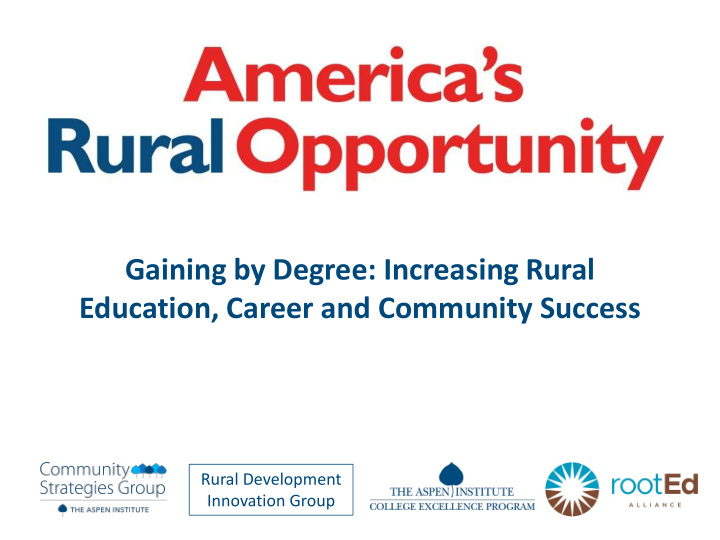



Gaining by Degree: Increasing Rural Education, Career and Community Success Rural Development Innovation Group
Janet Topolsky Executive Director, Aspen Institute Community Strategies Group
Noa Meyer Partner & Head of Philanthropy and Social Impact, BDT & Company President, rootEd Alliance
Gaining by Degrees: Increasing Rural Education, Career and Community Success Robert Templin Senior Fellow, The Aspen Institute College Excellence Program
Educational Attainment in Rural Communities
• Among the bottom 10% of Educational counties in the U.S. in terms Attainment in of postsecondary Rural educational attainment, Communities 84% are rural • There are 21 million adults without a college degree in rural America Those Left Behind: Gaps in College Attainment by Race and Geography Colleen Campbell, Center for American Progress, June 2019
An opportunity gap, not an ability gap • Rural students outperform urban peers in national standardized measures of math & English (NAEP) • 23% of rural students earn dual enrollment credits in high school compared to 16% nationwide
% of 1 % 18-24 Y 24 Year-Old lds E Enrolle led in in Colle ollege Fewer young people from rural areas 48% are enrolled 42% in college 29% Rural Suburban Urban National Center for Educational Statistics, Rural Education in America
Why? • Rural household income tends to be 20-25% less than in urban areas, making college less affordable for those in rural areas. • Geographic distance adds both additional costs and a psychological barrier for young people growing up in rural areas. • 41 million Americans - 82% of them rural - live in “higher education deserts” at least a thirty-minute drive from the nearest college or university
Ra Rates o of C Colle llege Enr nrollm lment in n the he Fi First F Fall a after Students from High S Scho hool G Gradua uatio ion low-income rural schools are 68% 65% least likely to go 53% to college 50% directly after high school Low-Income Higher Income Low-Income Higher Income Rural Schools Rural Schools Urban Schools Urban Schools National Student Clearinghouse Research Center, High School Benchmarks Report, 2013 i
Per ersistence R e Rates es from F First to Sec econd Y Yea ear of College ge Students from 88% 86% low-income 80% 79% rural schools who do enroll in college are less likely to persist Low-Income Higher Income Low-Income Higher Income Rural Schools Rural Schools Urban Schools Urban Schools National Student Clearinghouse Research Center, High School Benchmarks Report, 2013 i
College Completion Rates Six Years after High School Graduation, Class of 2012, Public Non-Charter Schools 77% 60% Many enroll in community 41% colleges Community Public 4-Year Private Non-Profit Colleges 4-Year National Student Clearinghouse, Completing College, 2019 National Report
College Completion Rates Six Years after High School Graduation, Class of 2012, Public Non-Charter Schools Rural students who persist 47% experience 41% higher college 36% completion rates than urban students Rural Suburban Urban National Student Clearinghouse, High School Benchmarks Report, 2019
$30,829 HS Degree $29,240 Those who do earn bachelor’s degrees often move to find work in metropolitan areas that $54,597 Urban offer more job Bachelor's Degrees Rural $42,260 opportunities and higher wages. $72,348 Graduate Degrees $54,513
Most rural economies have not recovered from the Great Recession
Yet there is a “skills gap” in rural America • Growth of low-wage service jobs • Unfilled jobs in rural communities that provide a living wage requiring postsecondary credentials • Misalignment of training programs with the needs of rural communities
Vacant jobs in rural communities that pay a living wage • Teachers • Registered Nurses • Accountants • Paralegals • Manufacturing production workers • Truck drivers • Healthcare professionals • Healthcare technicians • Retail sales managers • Welders • Automotive mechanics • Food service managers • HVAC & Refrigeration Mechanics & Installers • Public safety officers and EMT’s
The paradox of college attainment in rural areas • Improving rural economies increasingly depends upon residents with post-secondary credentials • Improving college access for rural students often means students leaving to attend college • College completion often accelerates rural out- migration of young adults
Rural community colleges are the linchpin • 428 rural community colleges across 43 states • 1.2 million students enrolled in rural colleges • Evidence from the Aspen Prize for Community College Excellence has shown that rural colleges have demonstrated remarkable success in areas such as equity outcomes and degree completion • Excellent rural community colleges serve special purposes in addition to postsecondary education as key employers, regional conveners, data analysts, and catalysts of economic development Lake Area Technical Institute has a partnership with Caterpillar called ThinkBIG, preparing students for high-skilled jobs in South Dakota.
Recommend
More recommend